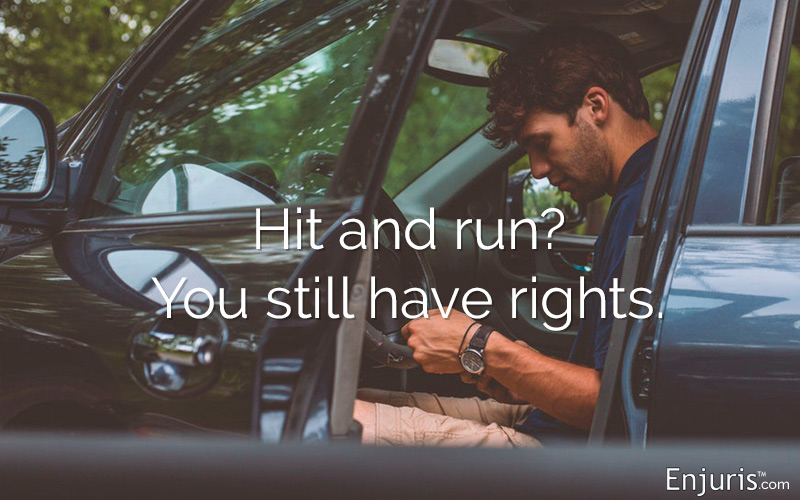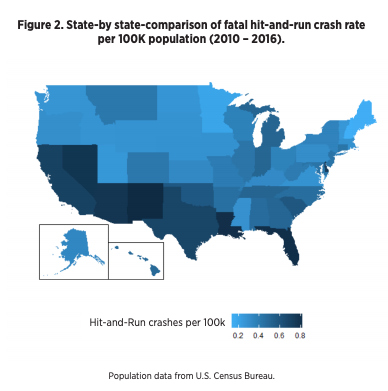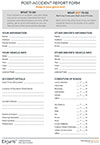
What to do when a driver flees the accident without stopping
A hit-and-run accident occurs when a driver hits another car, person, or piece of property and then leaves the scene without stopping to provide their personal information. In the United States, a hit-and-run accident occurs every 43 seconds.
This article examines car crashes in Montana where there’s a hit-and-run driver, including how often they occur, the laws that apply, and what to do if you’re involved in one.
Hit-and-run statistics
According to data compiled by the National Highway Traffic Safety Administration (NHTSA), there are approximately 682,000 hit-and-run crashes every year. In 2016, 2,049 people were killed in hit-and-run crashes (the most since NHTSA began compiling statistics in 1975). The number of fatal hit-and-run accidents has been increasing at an average rate of 7.2 percent per year since 2009.

by the AAA Foundation for Traffic Safety
In Montana, only 4 people were killed in hit-and-run crashes in 2016. This may be due, in part, to the rural makeup of the state. In general, rural areas tend to have fewer hit-and-run fatalities. (New Hampshire, Maine, and Minnesota routinely have the fewest hit-and-run fatalities.)
Montana hit-and-run laws and penalties
When it comes to hit-and-run laws and penalties, hit-and-runs can be broken into 2 groups:
- Accidents involving other people
- Accidents involving unattended vehicles or objects
Let’s take a quick look at both.
1. Accidents involving other people
Under Montana law, every driver who knows or “reasonably should have known” that they’ve been in an accident with another person must immediately stop their vehicle and do these four things:
- Provide their name, address, and registration number
- Provide their driver’s license (if requested)
- Render reasonable assistance to any person injured at the scene
- If anyone is injured at the scene, give notice to the local police department and remain at the scene until an on-duty police officer arrives and gives the driver permission to leave
A driver is NOT allowed to delegate the above tasks to any other person. In other words, if you’re involved in an accident that results in an injury, you can’t call your partner or friend and have them wait at the scene for the police while you take off for a scheduled appointment.
So what’s the penalty if you fail to follow these laws?
The penalty depends on the nature of the injury (if any):
- Accident with no injuries. Fine of $200–$300 and/or imprisonment for not more than 20 days. Subsequent convictions can increase the fine to $500 and the jail time to 6 months.
- Accident resulting in an injury. Fine of $100–$5,000 and/or imprisonment for a term of 30–365 days.
- Accident resulting in serious bodily injury or death. Fine not to exceed $50,000 and/or imprisonment for a term of 1–10 years. Also, revocation of your driver’s license.
2. Accidents involving unattended vehicles or objects
What happens if the driver strikes an unattended vehicle or an object (such as a detached trailer or telephone pole)?
If the driver collides with an unattended vehicle or an object, the driver must immediately stop and do the following:
- Take reasonable steps to locate and notify the operator or owner of the vehicle or object, or
- Leave written notice with the name and address of the driver, along with a statement explaining what happened.
Failing to take one of the above steps will result in a fine of $200–$300 and/or imprisonment of 20 days or less. Subsequent convictions can increase the fine to $500 and the jail time to 6 months.
| Montana Penalty for Hit-and-Run Crashes | ||
|---|---|---|
| Type of accident | Maximum penalty for fleeing the scene |
Statute |
| Damage to non-vehicle or unattended vehicle | 20 days in jail and/or $300 fine | M.C.A. § 61-7-118(1-3) |
| Accident with no injury | 20 days in jail and/or $300 fine | |
| Accident resulting in injury | 1 year in jail and/or $5,000 fine | |
| Accident resulting in serious injury or death | 10 years in state prison and/or $50,000 fine, revocation of driver’s license | |
Why wouldn’t a driver stop?
There are many reasons why a driver might flee the scene of an accident. Some of the more common reasons include:
- The driver is intoxicated or driving under the influence of drugs
- The driver is driving with a suspended license
- The driver doesn’t have car insurance
- There’s an outstanding warrant for the driver’s arrest
- The car is stolen
Environmental factors also impact the prevalence of hit-and-run accidents.
The greater the visibility of a crash (either due to more potential witnesses on heavily trafficked roads or better lighting conditions), the less likely a hit-and-run will occur.
Similarly, fleeing from an accident is almost 4.4 times more likely between midnight and 4 a.m. The reasoning is that driving at night often means:
- Lower visibility (thereby strengthening the belief that the driver will escape unnoticed)
- An increased likelihood of risky behaviors (such as driving while intoxicated or without a license)
Tweet this
Interestingly, recent studies have shown that there’s no relationship between the severity of hit-and-run penalties and the number of hit-and-run crashes. In other words, hit-and-run accidents are not less common in states with stricter penalties for fleeing the scene.
What should you do if you fled the scene of an accident?
While fleeing the scene of an accident is absolutely the wrong decision, it’s a common impulse. You may fear that the other driver will retaliate if you stop. Or, you may have tried to move your vehicle to a safe spot and lost track of the other vehicle in the process.
Whatever the reason, fleeing the scene of an accident is serious. In such a case, we recommend you contact a Montana criminal defense attorney to talk about how to make things right while still protecting your legal rights.
What to do if you’re the victim of a hit-and-run accident?
If you’re involved in a hit-and-run accident, your instinct might be to chase after the driver. This is never a good idea. In addition to putting yourself and others at risk, you stand a good chance of being pulled over for speeding.
Instead, take a deep breath and move your vehicle to a safe spot off the road, if possible.
Once you’re safe, call the police and report the accident. While waiting for the police to arrive, write down any information that you can remember about the other driver and vehicle, including:
- The vehicle make and model
- The license plate number and/or state
- The color of the vehicle
- Any distinguishing features (damage, rust, bumper stickers, etc.)
- A physical description of the driver (man or woman, tall or short, etc.)
- Contact information for any witnesses
 Accident Report Form
Accident Report Form
Sample post-accident report form to keep in your glove box - fill out at the scene or as soon as you can after a car accident
Download in PDF format![]()
Finally, contact your insurance company and file a claim. Montana is a no-fault insurance state, which means the one who causes the accident is liable for the damages.
Of course, if you can’t locate the other driver, filing a claim becomes more complicated. Your policy might still provide coverage assuming you purchased the necessary optional coverage. Examples of optional coverage that might cover your damages include:
- Uninsured motorist (UM) coverage. Provides coverage for bodily injury and property damage sustained by you or the passengers in your vehicle as a result of an accident involving an uninsured driver or a driver who can’t be located.
- Medical payments. This coverage pays certain medical and funeral costs for you or others in your vehicle injured or killed in an accident.
Finally, if you’ve been involved in a hit-and-run accident, consider contacting an experienced Montana personal injury attorney. An experienced attorney can help you understand your recovery options if the other driver can’t be located, or help you take legal action if the driver is eventually found.
See our guide Choosing a personal injury attorney.
